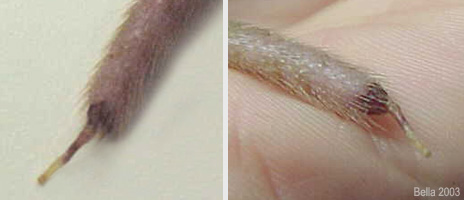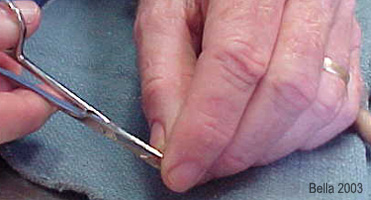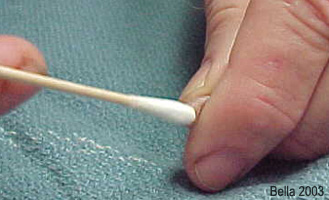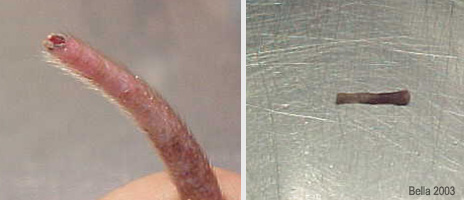Figure 1: Tail degloving in female rat.
Case history and photos
History
Adult female rat housed with cage mate, was noticed by the owner to have a tail injury in which the skin was shorn, and hanging, with a small ¼ inch length of bone showing. The cause of the injury was unknown. Attempts were made to give comfort believing the tail would heal without intervention.
Clinical Signs
The day of injury the rat was seen panting with her eyes closed and was obviously in pain. She kept licking the damaged tail causing it to bleed. Later that night the female lay at the bottom of her cage with her tail elevated on the ramp, which stopped the bleeding. She was given children’s Tylenol to reduce her pain.
On the second day the rat’s pain seemed to have subsided, and the owner cleaned the wound twice a day in an attempt to help the healing process.
On the fifth day the rat removed the excess skin. The bleeding was minimal, with signs of dead tissue along with more exposed bone than before.
The rat was brought to the veterinarian at this time after seeking advice.
Diagnosis
Degloving injury of tail. Owner unable to determine cause.
Treatment
Examination was completed by the vet, and determined that the exposed area of the tail had no blood flow. It was decided at that time to do a simple amputation of the exposed area so that the tail could heal properly. The vet determined the line of demarcation between that of viable bone and tissue and dead bone and tissue; where he then removed approximately 3/8 inch of bone from the tail. The remaining stub was then dabbed with an antibiotic powder. There was no bleeding during the time of the procedure. The rat was placed on oral Baytril to help prevent any infection, and to aid in resolving a simultaneous respiratory flare up.
Because this was a simple degloving, and the area was without sensation at that point, the vet chose to do the procedure without anesthesia. In a more serious degloving, involving bone and tissue that was still healthy, the rat would have to be put under anesthesia for the surgery. Often with tail injuries bone damage will occur causing the delicate blood vessels to be pulled apart leaving the remaining tail with no blood to sustain it, and no feeling. Skin will not grow back once a tail has been degloved, so it is imperative to remove the exposed bone in order to minimize risk of infection and gangrene.
Outcome
Healing of the tail stub occurred without further incident or infection.
Photos
 Photos 1 & 2: Shows site of degloved tail, and exposed bone. |
 Photo 3: Shows site at which vet is amputating. |
 Photo 4: Shows application of topical antibiotic to stub. |
 Photos 5 & 6: Shows amputated stub and the piece of tissue removed. |
*Note: It is important to seek treatment from a Veterinarian immediately in these type of injuries especially where there is severe tissue damage, and exposure of bone, in order to prevent further loss or infection.*
Case history and photos courtesy of Bellaratta’s Nest Rattery


